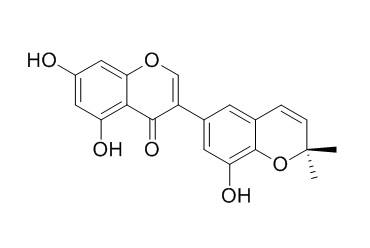Semilicoisoflavone B
Semilicoisoflavone B can inhibit sorbitol formation of rat lens incubated with a high concentration of glucose, indicates that it may be effective for preventing osmotic stress in hyperglycemia.
Inquire / Order:
manager@chemfaces.com
Technical Inquiries:
service@chemfaces.com
Tel:
+86-27-84237783
Fax:
+86-27-84254680
Address:
1 Building, No. 83, CheCheng Rd., Wuhan Economic and Technological Development Zone, Wuhan, Hubei 430056, PRC
Providing storage is as stated on the product vial and the vial is kept tightly sealed, the product can be stored for up to
24 months(2-8C).
Wherever possible, you should prepare and use solutions on the same day. However, if you need to make up stock solutions in advance, we recommend that you store the solution as aliquots in tightly sealed vials at -20C. Generally, these will be useable for up to two weeks. Before use, and prior to opening the vial we recommend that you allow your product to equilibrate to room temperature for at least 1 hour.
Need more advice on solubility, usage and handling? Please email to: service@chemfaces.com
The packaging of the product may have turned upside down during transportation, resulting in the natural compounds adhering to the neck or cap of the vial. take the vial out of its packaging and gently shake to let the compounds fall to the bottom of the vial. for liquid products, centrifuge at 200-500 RPM to gather the liquid at the bottom of the vial. try to avoid loss or contamination during handling.
Phytomedicine.2019, 56:48-56
The Journal of Korean Medicine2022, 43(3): 79-93.
Pharmaceutics.2021, 13(2):187.
Anticancer Res.2024, 44(3):1033-1044.
J Appl Pharm Sci.2022, 12(04):044-053
Genes Genomics.2020, 10.1007
Journal of Food and Drug Analysis2023, 31(3), 9.
Biomed Pharmacother.2024, 176:116765.
Front Pharmacol.2020, 11:683.
Huazhong Agricultural University2022, pp34.
Related and Featured Products
Biol. Pharm. Bull., 2010, 33(5):917-21.
Aldose reductase inhibitory compounds from Glycyrrhiza uralensis.[Pubmed:
20460778]
METHODS AND RESULTS:
We evaluated the inhibitory effects of components from the root of Glycyrrhiza uralensis (G. uralensis) on aldose reductase (AR) and sorbitol formation in rat lenses with high levels of glucose as part of our ongoing search of natural sources for therapeutic and preventive agents for diabetic complications. In order to identify the bioactive components of G. uralensis, 5 prenylated flavonoids (Semilicoisoflavone B, 7-O-methylluteone, dehydroglyasperin C, dehydroglyasperin D, and isoangustone A), three flavonoids (liquiritigenin, isoliquiritigenin, and licochalcone A), and two triterpenoids (glycyrrhizin and glycyrrhetinic acid) were isolated; their chemical structures were then elucidated on the basis of spectroscopic evidence and comparison with published data. The anti-diabetic complication activities of 10 G. uralensis-derived components were investigated via inhibitory assays using rat lens AR (rAR) and human recombinant AR (rhAR). From the 10 isolated compounds, Semilicoisoflavone B showed the most potent inhibition, with the IC(50) values of rAR and rhAR at 1.8 and 10.6microM, respectively.
CONCLUSIONS:
In the kinetic analyses using Lineweaver.Burk plots of 1/velocity and 1/concentration of substrate, Semilicoisoflavone B showed noncompetitive inhibition against rhAR. The results clearly indicated that the presence of a gamma,gamma-dimethylchromene ring is partly responsible for the AR inhibitory activity of isoprenoid-type flavonoids. Further, Semilicoisoflavone B inhibited sorbitol formation of rat lens incubated with a high concentration of glucose, indicating that this compound may be effective for preventing osmotic stress in hyperglycemia.
Mol Nutr Food Res . 2018 Mar;62(6):e1700633.
Glycyrrhiza uralensis and Semilicoisoflavone B Reduce Aβ Secretion by Increasing PPARγ Expression and Inhibiting STAT3 Phosphorylation to Inhibit BACE1 Expression[Pubmed:
29143445]
Abstract
Scope: Glycyrrhiza uralensis extract (GUE) has been reported to improve amyloid beta (Aβ)-induced cognitive deficits in mice. However, the mechanisms underlying this effect and the components involved have not been previously explored. Extracellular Aβ plaques are one of the major pathological hallmarks of Alzheimer's disease (AD). Therefore, decreasing Aβ levels is one strategy for preventing the etiology of AD. This study aims to test the effect of GUE and Semilicoisoflavone B (SB) on Aβ secretion and investigates the mechanism underlying this effect.
Methods and results: GUE and its bio-activated compound SB reduce Aβ secretion. We find that this effect contribute to the downregulation of the β-secretase-1 (BACE1) protein and mRNA. In a subsequent mechanism study, we find that GUE and SB regulate BACE1 transcription factors by inducing the expression of peroxisome proliferator activated receptor γ (PPARγ) and inhibiting the phosphorylation of signal transducer and activator of transcription 3. In addition, the effect of GUE and SB on BACE1 expression and Aβ secretion are attenuated by treatment with PPARγ-siRNA or its antagonist, GW9662.
Conclusion: These findings indicate that GUE and SB may function as PPARγ agonists, thereby inhibiting BACE1 expression and ultimately reducing the secretion of Aβ.
Keywords: Alzheimer's disease; BACE1; PPARγ; amyloid beta; Semilicoisoflavone B.



